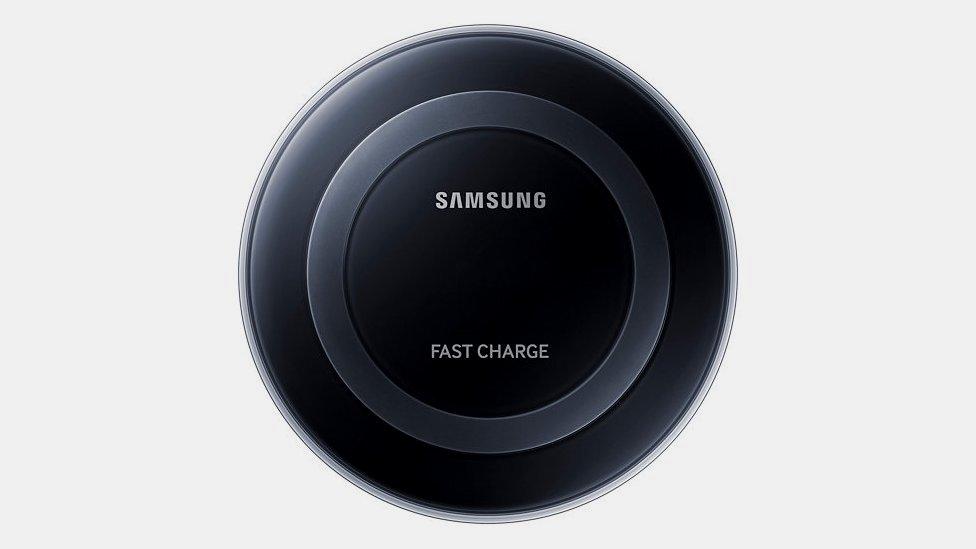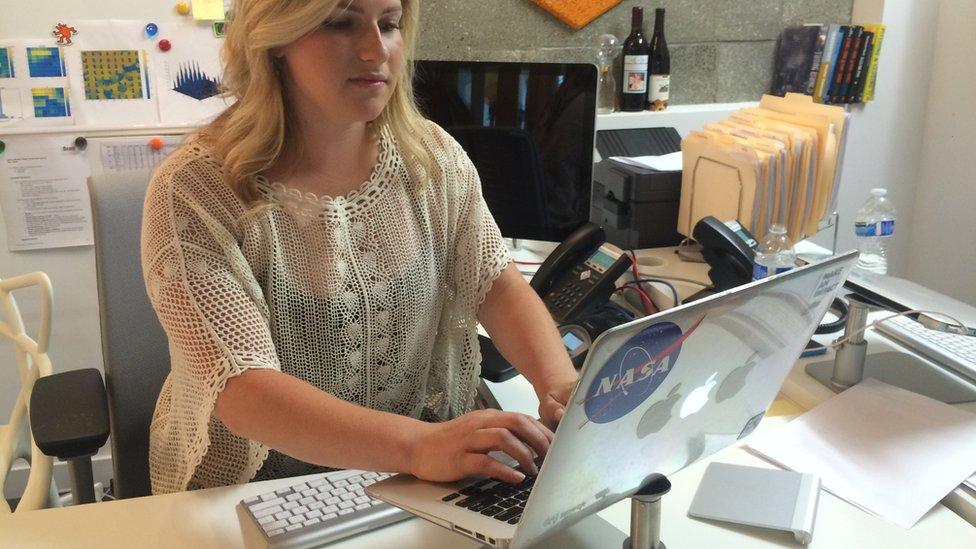Could we soon charge our phones through the air?
- Published
Can Meredith Perry achieve her dream of changing the world with wireless charging?
Can you imagine a world in which you never need to plug your phone in to charge again? You walk down the street or into a café or hotel and tiny beams of energy wirelessly charge your phone. That's the claim of one California-based entrepreneur and inventor.
Meredith Perry claims her wireless phone chargers will soon be as ubiquitous as Wi-Fi and her company, uBeam, is starting with wireless phone charging "to introduce the concept of wireless charging to the world." But the company has much bigger plans.
"There will be no more wires and ultimately there will be no more electrical outlets, you won't need electrical outlets when all devices are powered by uBeam," Ms Perry tells the BBC.
Meredith, 26, wowed the tech world in 2011 when as a university student she entered an inventing contest with a bulky prototype to beam ultrasound waves through the air to create an electric charge. That was the birth of uBeam and since then her company has attracted more than $23m (£15m) from investors.
Yet critics say they're wasting their money and that the science of uBeam is flawed at best.
They say that air is not a good conductor of airwaves and even if it did manage to beam a bit of energy to phones - it wouldn't be strong enough for a charge or it would be too directional. How many transmitters would be needed to charge everyone's phone in a single cafe or hotel lobby, they ask. Others fear the waves could hurt animals.
Critics and competitors
"Ultrasound is just higher in frequency than what humans can hear. We send that sound through the air, it vibrates the air particles and then it hits a receiver, which you can think about like a microphone," Ms Perry says.
"It vibrates that receiver at a frequency too fast for you to feel, and it converts that vibration into electricity and it charges your device."

Meredith Perry and her team at uBeam hope to bring their product to market in 2016
People sometimes fear something foreign or unknown, she argues.
"What's interesting is people aren't afraid of sound but they're afraid of energy," she says, adding that people are not afraid at concerts or when people speak, they're effectively beaming power or energy at you with their voices.
However, Ms Perry has not demonstrated the product publicly, fuelling critics who doubt her efficacy. Even so, the company has attracted some of Silicon Valley's most powerful and successful venture capitalists.
Mobile phone charging pads exist but uBeam - if it works - would be something entirely different. It's considered a holy grail, a concept Nikola Tesla first demonstrated with his "Tesla coil" in the 1890s.
"I know people who've seen it, credible people, and they say it's amazing. It works," says Josh Constine, a writer for TechCrunch. He says it's not unusual for a company like uBeam to stay "in stealth mode" by refusing to demonstrate the technology publicly, mainly to avoid "cheap knockoffs."

Wireless charging pads by companies like Samsung where you place your phone on to charge are already on the market
"When you're talking about hard science there are real secrets involved. Sometimes what works is something that no one else tried," Constine says. "As long as you're first and you have the biggest user base, you will win."
Potential game-changer
Robert Scoble, who is known as a popular "technical evangelist" in Silicon Valley as the "Scobelizer" on social media, says the technology could be a game-changer for consumers.
"It changes a lot. It would be cool to walk into a bar and have my phone start to charge," says Scoble, who also has not seen the product work but knows people who have.
But the success of uBeam depends on its efficiency, he says. It's one thing to charge a mobile phone wirelessly, but to power the growing number of electronics we rely on is a much bigger job.
"How many receivers do I need to make this system work? How expensive is it? What's the efficiency? If it takes two hours to charge my Apple watch plugging in and it takes 20 hours to do it using this system, then obviously people won't do it," he says.

Before getting uBeam up and running Meredith Perry's ambition was to go into space
Ms Perry has not shared many of those details yet. But she says a product will be launched in 2016. Inside her Santa Monica-based start-up in California she shows a sleek mobile phone case mock-up.
Space dreams
Initially, customers would need to buy the phone cases and the system for their homes. But eventually, she says, uBeam transmitters will be installed in street lamps, and inside gyms, movie theatres, offices, hotels and restaurants.
She's even got her eye on spacecraft and fulfilling her dream of space exploration. The young entrepreneur planned to become an astronaut before creating uBeam and says she's already been approached to outfit a spacecraft with a uBeam charging system.
"Oh, I'll get there," she says when asked is she still dreams of going to space, adding that uBeam will likely get there first.
"But that's ok. uBeam is a part of me."

The Digital Disruptors is a series about the people and companies shaking up business with new technology.
